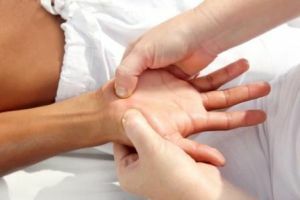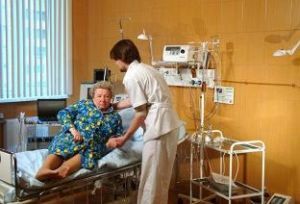Cardioembolic stroke - a kind of acute circulatory disorders in the brain, resulting from blockage of arteries to tear thrombus in cardiac pathology. This condition is also called cerebral infarction. Those at risk include the elderly, have heart disease (myocardial infarction, arrhythmias, heart failure). When delayed aid stroke can lead to fatal complications, and (paralysis, coma, cerebral edema, cerebrovascular dementia).

The causes and mechanism of development
Risk factors for embolic stroke are:
- Acute and chronic diseases (myocardial heart muscle, mitral valve stenosis, endocarditis, calcification, cardiomyopathy, heart tumor, aneurysm, rheumatism).
- A defect in the heart walls.
- Propensity to thrombosis.
- Increase in blood clotting.
- Jumps in blood pressure. Increasingly it is developing a stroke in people with high blood pressure.
- Slowing of blood circulation process.
- blood diseases.
- Smoking.
- The presence of diabetes mellitus.
- Autoimmune diseases are accompanied by vascular lesion.
In the development of disease play a role of the following violations:
- blood clots;
- damage to vascular endothelium (inner wall of the vessel);
- thrombus instability;
- violation of myocardial work.

Self embolus is a thrombus detached fragment or a clot caught in cerebral blood flow and clog blood vessels (brain, basilar and carotid arteries of the brain). Initially when cardioembolic stroke heart cavity formed thrombus.
Against the background of the vascular wall damage (atherosclerosis frequently observed) deposited fibrin, forming a film. There's also deposited platelets and white blood cells. Clot forms, which gradually compacted. In sharp increase blood clot or insufficient adhesion to endothelium thrombus can break off and be carried away on a brain circulation. Stroke develops when a decrease in the arterial lumen by 70% or more.
Signs and symptoms
The most common manifestations of ischemic cardioembolic stroke are:
- Paralysis and paresis of the upper and (or) of the lower limbs. Paralysis is called a complete lack of movement. In stroke end-often broken on the side opposite the affected area of the brain. Hemiparesis possible (volume reduction hands and feet movements on 1 side) or monoparesis.
- sensitivity reduction or complete loss of it.
- Aphasia (impaired speech pronunciation of words or misunderstanding).
- Diplopia (double vision of objects in the eyes).
- Violation of the visual fields.
- Hallucinations. Most often they are visual. A person can prividetsya images and objects that do not actually exist.
- Photopsias (flash before his eyes).
- Loss of coordination and orientation in space.
- Difficulty eating. It appears choking.
- Cerebral symptoms (nausea, vomiting, headache).
- Memory impairment. Stroke possible amnesia.
- Facial asymmetry. The reason - a paresis of mimic muscles. When possible cardioembolic stroke lowering corner of the mouth on the one hand and smoothness of nasolabial folds.
- Dizziness.
- Difficulty swallowing food.
- Hiccups.
- Hoarseness.
- Apraxia. Sick people can not perform actions in the correct sequence.
- Aprosodiya (violation of the implementation of phonetics in speech).
- Anosognosia (inability to perceive existing disease).
- Emotional disorders (anxiety, depression, anxiety).

Diagnosis of the disease on the basis of symptoms alone are not. Required laboratory (general clinical analyzes, lipidogram, biochemical test, coagulation) and instrumental investigations (CT, MRI, angiography, Doppler, electroencephalography). The differential diagnosis is carried out with viral and bacterial encephalitis, transient ischemic attacks, Tumors and brain injuries.
Treatment
Combined therapy of cardioembolic stroke include:
- The use of medicines. treat basis is the use of antiplatelet agents, anticoagulants, and antifibrinolytics. Used low molecular weight heparin, clopidogrel, and streptokinase. When acute cerebrovascular shown neuroprotective (Semaks, Cerebrolysin, Mildronate, Meksidol, Piracetam, Glycine, Pentoxifylline, Cavinton). They can improve the metabolism and microcirculation. Nootropics help to normalize the higher mental functions. Perhaps the use of cardiac drugs (beta-blockers, calcium antagonists).
- pressure normalization.
- Struggle with brain swelling.
- Oxygen therapy.
- Surgical intervention.
During rehabilitation patients are encouraged to eat a diet (to include in the menu products, blood thinners, to abandon fatty and fried foods), gymnastics and going to physiotherapy. Good effect in stroke give massages, hydrotherapy and electrical stimulation. When speech Abuse effective classes with speech therapist. The prognosis of cardioembolic stroke relatively unfavorable. It improves during drug therapy for the first 3-6 hours. The mortality is about 20%.



